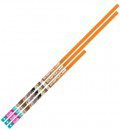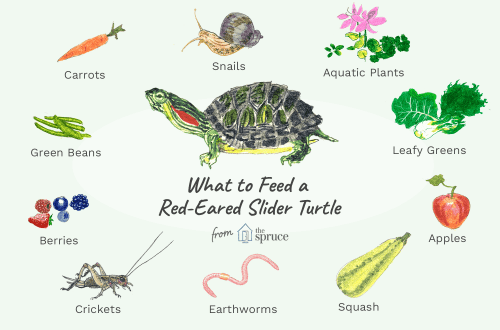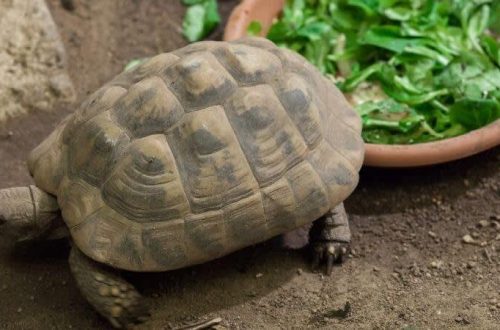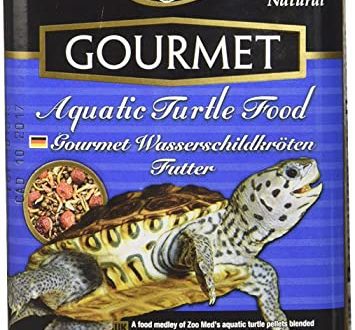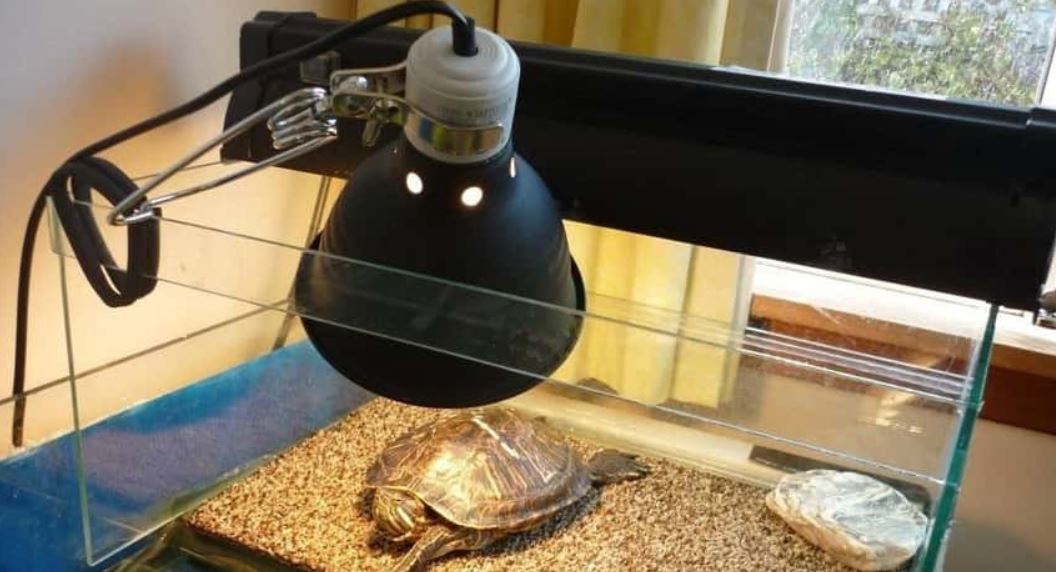
UV lamps – all about turtles and for turtles
General brief information about ultraviolet lamps
The reptile ultraviolet lamp is a special lamp that allows the absorption of calcium in the body of turtles, and also stimulates their activity. You can buy such a lamp at a pet store or order it by mail via the Internet. The cost of ultraviolet lamps is from 800 rubles and more (on average 1500-2500 rubles). This lamp is necessary for the proper maintenance of the turtle at home, without it the turtle will be less active, eat worse, get sick, it will have a softening and curvature of the shell and fractures of the paw bones.
Of all the UV lamps currently on the market, the best and most affordable are Arcadia’s 10-14% UVB lamps. It is better to use reflector lamps, then they are more efficient. Lamps with 2-5% UVB (2.0, 5.0) produce little UV and are almost useless.
The lamp must be switched on approximately 12 hours a day from morning to evening and at the same time as the heating lamp. For aquatic turtles, the UV lamp is located above the shore, and for land turtles, it is usually along the entire length of the terrarium (tube). The approximate height to the bottom of the terrarium is 20-25 cm. It is necessary to change the lamp for a new one about 1 time per year.
What is an Ultra Violet (UV) lamp?
A reptile UV lamp is a low or high pressure discharge lamp specifically designed for irradiating animals in a terrarium, producing ultraviolet radiation in the UVA (UVA) and UVB (UVB) ranges that is close to natural sunlight. Ultraviolet radiation in ultraviolet lamps arises from mercury vapor inside the lamp, in which a gas discharge occurs. This radiation is in all mercury discharge lamps, but only from the “ultraviolet” lamps it comes out due to the use of quartz glass. Window glass and polycarbonate almost completely block ultraviolet B spectrum, plexiglass – completely or partially (depending on additives), transparent plastic (polypropylene) – partially (a quarter is lost), ventilation mesh – partially, so the ultraviolet lamp should hang directly above the turtle. A reflector is used to amplify the radiation of the UV lamp. Spectrum B ultraviolet produces vitamin D3 (cholecalciferol) in reptiles in the range of 290-320 nm with a peak of 297.
What is a UV lamp for?
UVB lamps help to absorb the calcium that turtles get from or in addition to food. It is necessary for the strengthening and growth of bones and shells, without it rickets develops in turtles: the bones and shells become soft and brittle, which is why turtles often have fractures of limbs, and the shell is also very curved. Calcium and ultraviolet light are especially necessary for young and pregnant turtles. In nature, land herbivorous turtles almost do not get vitamin D3 from food, and it is necessary for the absorption of calcium (chalk, limestone, small bones), so it is produced in the body of land herbivorous turtles due to the sun’s radiation, which gives ultraviolet of different spectra. Giving tortoises vitamin D3 as part of top dressing is useless – it is not absorbed. But predatory aquatic turtles have vitamin D3 from the insides of the animals they eat, so they can absorb vitamin D3 from food without ultraviolet light, but its use is still desirable for them. Ultraviolet A, which is also found in UV lamps for reptiles, helps reptiles see food and each other better, has a big impact on behavior. However, only metal halide lamps can emit UVA with an intensity close to natural sunlight.
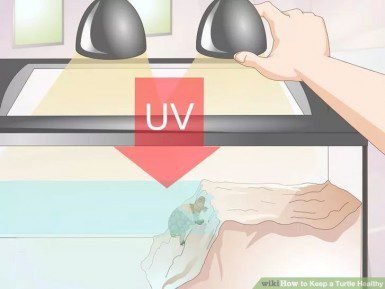
Is it possible to do without a UV lamp? The absence of a UV lamp affects the health of the reptile 2 weeks after the cessation of irradiation, especially for land herbivorous turtles. For carnivorous tortoises, when fully fed with a variety of prey items, the effect of the absence of ultraviolet is not so great, however, we recommend using ultraviolet lamps for all species of turtles.
Where to buy a UV lamp? UV lamps are sold in large pet stores that have a terrarium department, or in specialized terrarium pet stores. Also, lamps can be ordered at online pet stores in major cities with delivery.
Are ultraviolet lamps dangerous for reptiles? The ultraviolet emitted by special lamps for reptiles is safe for humans and their terrarium dwellers*, provided that the installation and use of lamps prescribed by manufacturers is observed. Additional information on lamp installation rules can be found in this article and in the attached table.
How long should the UV lamp burn? The ultraviolet lamp for reptiles should be turned on all daylight hours (10-12 hours). At night, the lamp must be turned off. In nature, most species of turtles are active in the morning and evening, while hiding and resting in the middle of the day and at night, when the natural ultraviolet intensity is not so high. However, most reptile UV lamps are much weaker than the sun, so only by running all day long can such lamps give turtles the study they need. When using more intense UV lamps (14% UVB with a reflector or more), it is necessary that the turtles have the opportunity to go into the shade, or limit the time the turtle stays under the UV lamp through a timer, depending on the type of turtle and its habitat.
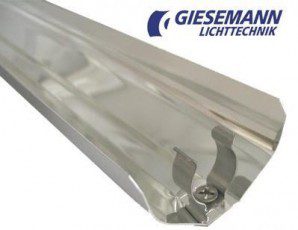 At what height from the turtle should it be placed? The approximate height of the lamp above the ground in a terrarium or aquarium shore is from 20 to 40-50 cm, depending on the power of the lamp and the percentage of UVB in it. See lamp table for details.
At what height from the turtle should it be placed? The approximate height of the lamp above the ground in a terrarium or aquarium shore is from 20 to 40-50 cm, depending on the power of the lamp and the percentage of UVB in it. See lamp table for details.
How to increase the intensity of the UV lamp? To increase the intensity of an existing UV lamp, you can use a reflector (purchased or homemade), which can amplify the lamp’s radiation up to 100%. The reflector is usually a curved structure made of mirror aluminum that reflects the light from the lamp. Also, some terrariumists lower the lamps lower, since the higher the lamp is, the more its light is scattered.
How to install a UV lamp? Compact UV lamps are inserted into the E27 base, and tube lamps into T8 or (more rarely) T5. If you have bought a ready-made glass terrarium or aquaterrarium, then it usually already has lights for the heat lamp and UV lamp. To determine which T8 or T5 UV lamp is right for you, you need to measure the length of the lamp. The most popular lamps are 15 W (45 cm), 18 W (60 cm), 30 W (90 cm).
For any terrarium lamps, it is recommended to use special terrarium lamps, which have a longer service life, are designed for higher lamp power due to ceramic cartridges, may have built-in reflectors, special mounts for use in a terrarium, may have moisture insulation, splash protection, are safe for animals . However, most use cheaper household lamps (for compacts and heating lamps, table lamps on a clothespin, and for T8 lamps, a fluorescent lamp shade in a pet store or in the construction market). Further, this ceiling is attached from the inside of the aquarium or terrarium.
T5 ultraviolet lamp, metal halide lamps are connected through a special starter!
In order to use the ultraviolet radiation of the lamps rationally and more efficiently, compact fluorescent lamps with an arcuate tube should be installed horizontally, and the same lamps with a spiral tube should be installed vertically or at an inclination of about 45 °. For the same purpose, special aluminum reflectors should be installed on linear fluorescent lamps (tubes) T8 and T5. Otherwise, a significant part of the lamp’s radiation will be wasted. High pressure discharge lamps are traditionally suspended vertically and do not need an additional reflector as they are built in.
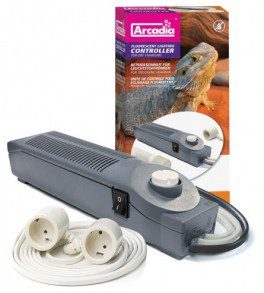
The power consumption of linear T8 lamps is related to their length. The same applies to linear T5 lamps, with the difference that among them there are pairs of lamps of the same length with different power consumption. When choosing a lamp for a terrarium along the length, it is necessary to pay attention to the capabilities of the ballast (ballast). These devices are designed to work with lamps having a certain power consumption, which must be indicated on the marking. Some electronic ballasts can operate lamps over a wide power range, such as 15W to 40W. In a cabinet luminaire, the length of the lamp invariably determines the distance between the rigidly fixed sockets, so that the ballast included in the luminaire kit already corresponds to the power of the lamps. Another thing is if the terrariumist decides to use a controller with a free armature, such as Arcadia Controller, Exo Terra Light Unit, Hagen Glo Light Controller, etc. At first glance, it may seem that these devices are not limited by the length of the lamp used. In fact, each such device has a control gear for lamps with a strictly defined power consumption, and therefore with a certain length.
The UV lamp is broken. What to do? Remove and wash everything very cleanly in the terrarium and in other places where fragments and white powder from the lamp could get, ventilate the room more, but not less than 1 hour. The powder on the glasses is a phosphor and it is practically non-toxic, there is very little mercury vapor in these lamps.
What is the lifespan of the UV lamp? How often to change it? Manufacturers usually write on the packages of UV lamps that the lamp life is 1 year, however, it is the operating conditions, as well as the needs of a particular type of turtle in ultraviolet radiation, that determine the service life. But since most tortoise owners don’t have the ability to measure their UV lamps, we recommend changing the lamps once a year. Currently the best manufacturer of UV lamps for reptiles is Arcadia, their lamps can be used for about 1 years. But we do not recommend using lamps from Aliexpress at all, as they may not give out ultraviolet at all.
A year later, the lamp continues to burn as it burned, but when it is used for 10-12 hours a day at the same height, its radiation intensity decreases by about 2 times. During operation, the composition of the phosphor with which the lamps are filled burns out, and the spectrum changes to a longer wavelength. Which significantly reduces their effectiveness. These lamps can be lowered or used in addition to a new UV lamp, or for reptiles that need less strong UV light, such as geckos.
What are ultraviolet lamps?
- Type: 1. Linear fluorescent lamps T5 (approx. 16 mm) and T8 (approx. 26 mm, inch). 2. Compact fluorescent lamps with E27, G23 (TC-S) and 2G11 (TC-L) base. 3. High pressure metal halide lamps. 4. High-pressure mercury discharge lamps (without additives): clear glass, frosted glass, semi-frosted glass, and translucent embossed glass.



- Power and length: For T8 (Ø approx. 26 mm, base G13): 10 W (30 cm long), 14 W (38 cm), 15 W (45 cm), 18 W (60 cm), 25 W (75 cm), 30W (90cm), 36W (120cm), 38W (105cm). The most common lamps and shades on sale are: 15 W (45 cm), 18 W (60 cm), 30 W (90 cm). For unpopular lamp sizes, it can be difficult to find suitable fixtures. Lamps with a length of 60 and 120 cm were previously labeled as 20 W and 40 W, respectively. American lamps: 17 W (approx. 60 cm), 32 W (approx. 120 cm), etc. For T5 (Ø approx. 16 mm, base G5): 8 W (approx. 29 cm), 14 W (approx. 55 cm), 21 W (approx. 85 cm), 28 W (approx. 115 cm), 24 W (approx. 55 cm), 39 W (approx. 85 cm), 54 W (approx. 115 cm). There are also American lamps 15 W (approx. 30 cm), 24 W (approx. 60 cm), etc. Compact fluorescent lamps E27 are available in the following versions: 13W, 15W, 20W, 23W, 26W. Compact fluorescent lamps TC-L (2G11 base) are available in 24 W (approx. 36 cm) and 55 W (approx. 57 cm) versions. Compact fluorescent lamps TC-S (G23 base) are available in the 11 W version (bulb approx. 20 cm). Reptile metal halide lamps are available in 35W (mini), 35W, 50W, 70W (spot), 70W (flood), 100W, and 150W (flood). Lamps “flood” different from the “spot” (ordinary) bulb increased in diameter. High pressure mercury lamps (without additives) for reptiles are available in the following versions: 70W, 80W, 100W, 125W, 160W and 300W.
- On the spectrum: 2% to 14% UVB. For turtles, lamps from 5% UVB to 14% are used. By choosing a lamp with UV 10-14 you ensure a longer life. You can hang it first higher, then lower it. However, 10% UVB of a T5 lamp produces more intensity than a T8 lamp, and the same percentage of UVB can be different for 2 lamps from different manufacturers.
- By cost: In most cases, the most expensive are T5 lamps and compacts, and T8 lamps are much cheaper. Lamps from China are cheaper, but they are worse in quality than lamps from Europe (Arcadia) and the USA (Zoomed).
Where to put used UV lamps? Mercury lamps must not be thrown into the trash! Mercury belongs to toxic substances of the first hazard class. Although inhalation of mercury vapor does not kill instantly, it is practically not excreted from the body. Moreover, exposure to mercury in the body has a cumulative effect. When inhaled, mercury vapor is adsorbed in the brain and kidneys; acute poisoning causes destruction of the lungs. Initial symptoms of mercury poisoning are nonspecific. Therefore, the victims do not associate them with the true cause of their illness, continue to live and work in a poisoned atmosphere. Mercury is especially dangerous for a pregnant woman and her fetus, since this metal blocks the formation of nerve cells in the brain and the child can be born mentally retarded. When a mercury-containing lamp breaks, mercury vapor pollutes up to 30 meters around. Mercury penetrates plants and animals, which means they will be infected. When eating plants and animals, mercury enters our body. ==> Lamp collection points
What should I do if the lamp flickers? A slight flicker occurs at the socles (ends) of the tube lamp, i.e. where the electrodes are. This phenomenon is quite normal. There may also be flickering when starting a new lamp, especially at low air temperatures. After heating, the discharge stabilizes and the undulating flicker disappears. However, if the lamp does not just flicker, but does not start, then it flashes, then it goes out again and this continues for more than 3 seconds, then the lamp or lamp (starter) is most likely faulty.
Which lamps are not suitable for turtles?
- blue lamps for heating, treatment;
- ultraviolet lamps for money;
- quartz lamps;
- any medical lamps;
- lamps for fish, plants;
- lamps for amphibians, with a spectrum less than 5% UVB;
- lamps where the percentage of UVB is not specified, i.e. conventional fluorescent tubular lamps, such as Cameleon;
- lamps for drying nails.
Important information!
- Be careful when ordering from America! Lamps can be designed for 110 V, not 220 V. They must be connected through a voltage converter from 220 to 110 V.
- E27 compact lamps often burn out due to power surges. There is no such problem with tube lamps.
Turtles are suitable for the following UV lamps:
Turtles are suitable for lamps that have about 30% UVA and 10-14% UVB in their spectrum. This should be written on the packaging of the lamp. If it is not written, then it is better not to buy such a lamp or to clarify about it on the forum (before buying). At the moment, T5 lamps from Arcadia, JBL, ZooMed are considered the best lamps for reptiles, but they require special shades with starters.
Red-eared, Central Asian, Marsh, and Mediterranean tortoises are in Fergusson Zone 3. For other tortoise species, see species pages.




